
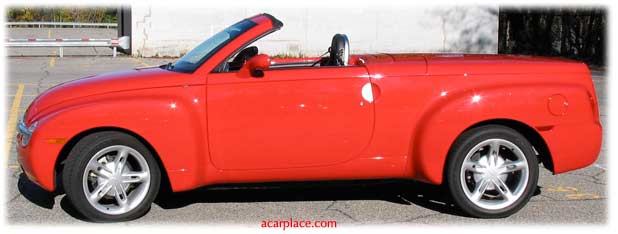
| Review Notes: 2005 Chevrolet SSR Automatic | |
| Unusual features | Well-designed convertible hardtop; unusually well-done retro styling |
| Above Average: | Fun factor, instant acceleration from any speed |
| Needs Work In: | Daft cruise control, minor squeaks and rattles |
| EPA gas mileage | 17 city, 23 highway (automatic; manual is 16/26) but expect less |
One of the happier results of a new spurt of special-purpose cars and trucks is the Chevrolet SSR, a truck with almost universal appeal, thanks to its attractive design, formidable performance, and pleasant ride. While the Plymouth Prowler and PT Cruiser are love-hate designs, most people at least enjoy the SSR; and, unlike the Audi TT, Volkswagen New Beetle, or Ford Thunderbird, the SSR can back up its looks with both performance and function.
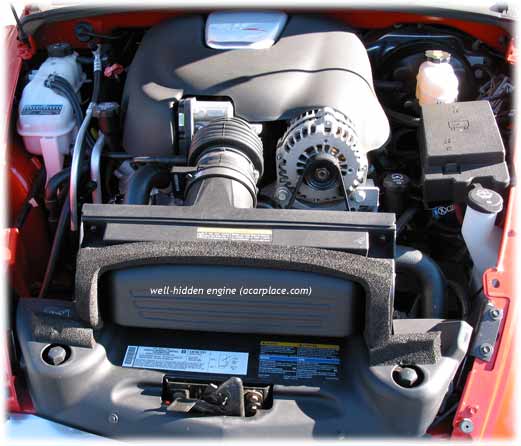
The 2005-06 Chevy SSR is powered by a high-performance V8, putting out around 300 horses more than classic Chevy pickups — that is, 390 horsepower, with a whopping 405 lb-ft of torque. The V8 makes the SSR feel and sound more like a Corvette than a Silverado, since that’s where the engine is from (a version is supplied with some pickups and has a similar, though much more muted, sound).
Thanks to ample low-rpm power, this engine provides sudden acceleration whenever it’s demanded, with kick limited only by the traction control (which can be shut off rather easily from the center console). The burbling muscle-car exhaust instantly turns into a full modified-muscle roar on heavy throttle, as the transmission immediately downshifts. There’s no cushioning in the transmission – when it shifts, it does so quickly and often with a jolt, as it should in a car like this.
No matter how fast or slow the SSR is going, it can instantly be flung forward at will or whim. The power is unlike that of most modern cars; you don’t have to worry about revving, you don’t have to wait for the transmission to catch up, and you don’t have to deal with “torque management” as the engine cuts its own power for smooth, transmission-saving shifts. Instead, you get a nice, beefy automatic tuned for instant results.
When the pedal is floored, a tremendous boost comes in – or, if you’re already moving, you start to accelerate, the engine slams into a lower gear, and then the boost comes, coupled with an umistakeable and well-tuned roar from the engine. When the transmission shifts again, accompanied by a squeal of drive belts, acceleration dips slightly but doesn’t fall as much as it would in most vehicles with a four-speed automatic. It takes almost no time or effort to get to quite illegal speeds, and quite a bit of restraint to obey GM’s safe driving policy.

The 2003-04 SSR had a 5.3 liter engine that went from 0-60 in 7.6 seconds – about the same as a Chrysler 300M, with the extra power and torque going into pushing over two tons of
weight. The 2005 SSR does the same 0-60 in just 5.5 seconds, quicker than the SRT-4 or Audi TT, making it a terribly fun car that’s much easier to drive than a Camaro SS, Viper, or, for that matter, the far-less-functional and claustrophobic Audi TT.
Gas mileage is, according to the EPA, actually reasonable for a pickup, but since (like everyone else) we drove the SSR the way it’s meant to be driven, we tended to get rather low mileage – about 13-14 mpg in the city. That’s about the same as a Yukon Denali – more spacious and feature-laden, but nowhere near as much fun.
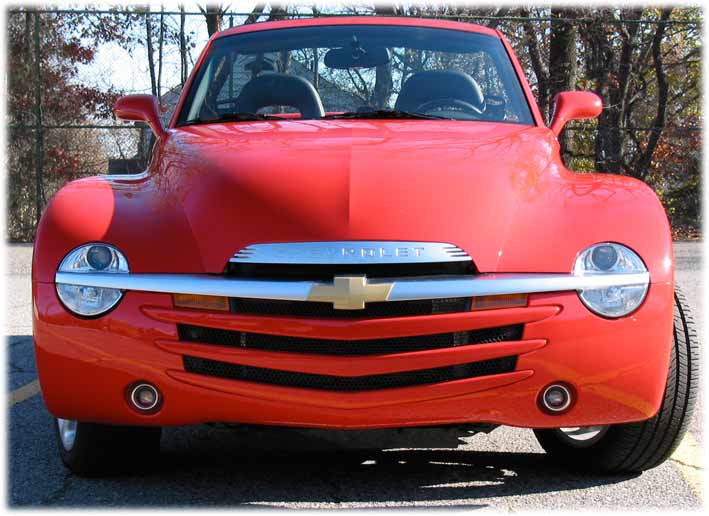
The ride is good for a high-performance vehicle, especially one based on a truck (the
minivan-like TrailBlazer). While rather firm, it does cushion bumps and road problems so that driving the SSR brings you close to the road but doesn’t actually hit you with it. We found the ride to be more comfortable than many non-performance trucks, and it handles ruts, speed bumps, and roads that resemble rumble strips well, without shocks or fuss.
Cornering is good, but by no means up to Camaro or Corvette levels; this is one place where you realize it’s good to be close to the ground. That said, the SSR is a great straight-line runner that can still probably beat any traditional muscle car on a curvy course. The traction control manages the power well on launch so that sometimes you get a “bog” effect, but go where you intend to go, instead of having instant power that launches you in
the wrong direction.
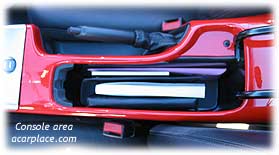
Most of the time, the traction control is not needed, and few drivers are likely to pass the limits of the SSR’s cornering. The tires are quiet and not prone to squealing, and the brakes are quite good and predictable.
Though you can drive quickly in the SSR, it might take longer to get anywhere, as people stop, stare, and ask you about it. We remember our first drive in the PT Cruiser being similar – but when the PT became a 120,000-vehicle-per-year success, the stares stopped. The SSR is still rare, and always will be, with production limited by the factory’s capacity (and sales limited by the rather steep price tag).
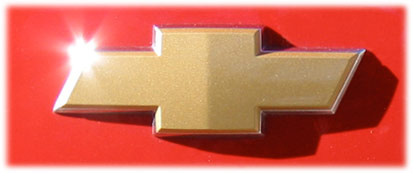
The exterior is straight out of Chevy’s pickup-truck past, with the rounded curves and low styling of an era when pickups were more likely to have a straight-six than any other engine, with modern Chevrolet styling touches as well. The flowing lines have a minimal impact on the functionality of the truck, which retains a small but usable bed and has ample room for two inside (which used to be the norm for pickups). The striking headlights put out a well-focused, strong beam pattern, despite the chrome that seems to split them in two (the top half is the headlights, and the bottom half is the bright lights. Fog lights are underneath).
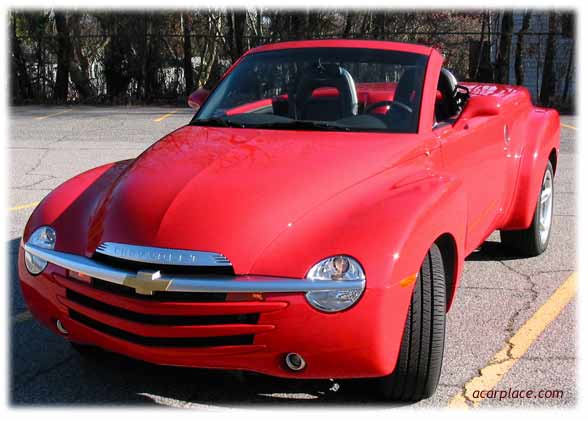
The design touches of the SSR are pervasive and consistent, starting with the door latch – a chrome latch, set sideways, and easier to operate than it sounds. The door locks themselves are the old-fashioned type, again chrome, with the easy-to-pull tops that started to disappear in the 1970s and were well and truly gone by the 1990s. Design elements include the usual black plastic along with generous amounts of a dull chrome material, a wood-like material (it may actually have been wood), and body-colored metal, in our case bright red. It all works well together.
Thankfully, the standard Chevy pickup instrument panel was replaced by a more sporty, if less informative, setup with deeply recessed gauges – a big speedometer going to 140 mph, an equally big tachometer, and smaller gas gauge, oil pressure, and thermometer. Carrying on the retro look is an optional set of three small gauges at the bottom of the center stack (or what would be the center stack in a standard car), though their function is unusual: one is for outside temperature, one for torque, and one for voltage.
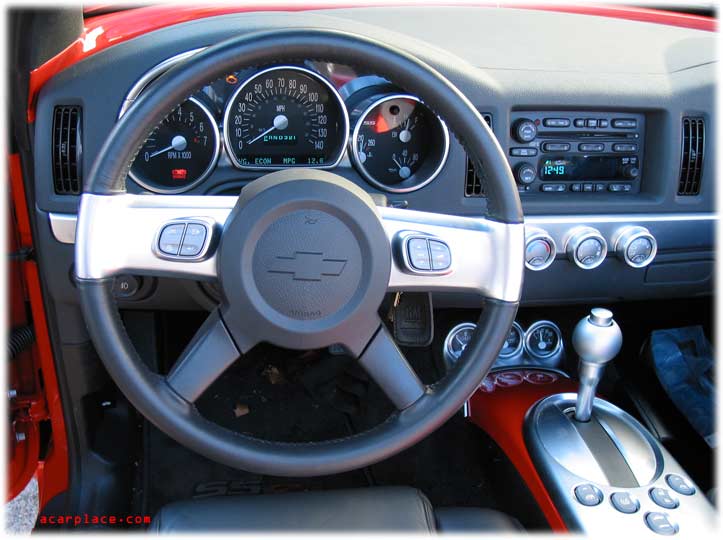
Control buttons for the windows, top, and locks are spread out across the top of the dull-metal center console; at night, a dim amber light shines from the rear view mirror to keep the five large switches visible without interfering with night vision. The light is relieves the normal blackness of most car interiors, at, we suspect, lower cost than illuminating the buttons themselves; its amber color allows the driver to see the buttons and surrounding area without losing night vision. The dome light itself is surprisingly bright considering it’s also built into the base of the mirror.
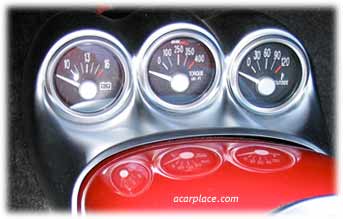
Less fortunate is the placement of the seat controls, which are in their standard position at the base of the seats; there is almost no room between the door and the seat, so reaching down to move the seats or turn the seat heat on or off can be impossible. Back incline is handled by a mechanical lever, while bolster and fore-aft movement are handled electrically, along with overall tilt.

The standard GM stereo is in the usual place in the dashboard, but speakers are placed behind the seats as well as in the doors, and duplicate controls are in the steering wheel as a standard feature. The stereo is very good, as one might expect. The standard GM headlight button is also present, with GM’s usual restricted choices – you can have automatic headlights, parking lights only, or headlights on (there’s no plain headlights-off position). Pushing the center of the switch gets fog lights.
Two cupholders and one sliding tray for coins and cards are provided. The slide-out cupholder works nicely but won’t hold a large cup, but the fold-out one attached to the side of the center console (it can be removed and placed on either side) will. The center console has a storage area with a locking cover; it can hold not just the owner’s manual, but also a decent number of CDs. There is also a moderately sized glove compartment.
We noted unusually good visibility before, and it’s worth noting again: most convertibles have large blind spots, but the solid-roof design may help the SSR to avoid that. What’s more, the headlights are both powerful and very well focused, unusual in American cars. The only down-side is the sun visors, which are neither long enough nor especially well engineered: they don’t have the right angle when moved to the side. Most of the time this was not a problem.
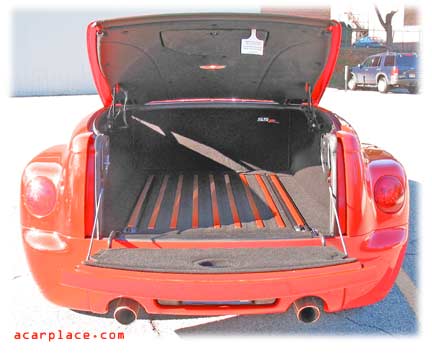
Though the SSR is attractive with its hard roof on, it’s more fun with the roof off, and it’s easy to go from one to the other. A press of a button – admittedly a 25 second long press – disengages the roof lock, opens the cover for the storage area, and folds the roof neatly behind the seats and ahead of the bed. The roof goes back on the same way – just press and hold down until it locks into place and the storage area cover folds back on, with no heavy latches to pull. The convertible design doesn’t interfere with function much, other than taking up some storage space: unlike the past Cavalier and Camaro, you don’t have to avoid the windshield when getting in or out, and visibility is good with roof on or off. While there is some wind noise with the roof on, particulary at fast highway speeds, there is less than in a fabric-topped convertible. Without the roof, wind buffeting is minimal even at moderate highway speeds.
One of the subtle, intelligent design features is the window lowering slightly when the door opens; when you close the door, the window pops back up again to make a better seal. Generally, the convertible system seems to be a much more convenient design than most; the dual tonneau covers (one for when the top is on, one for when it is stowed) is particularly clever.
On the utilitarian side, the SSR has much more storage than most roadsters, thanks to its pickup bed. It isn’t standard-sized, even for a small pickup, but it can still store quite a bit of cargo – and, albeit with some effort, you can take off the standard hard pickup bed cover and carry tall things, as well. That bed cover is a little strange in one regard: while you open the bed by popping the cover up, and then reaching in and unlatching the standard pickup gate. But you can’t just open and shut the bed cover; to close it, you have to have the gate open. So it’s open the top, then the gate, then close the top, then close the gate. It’s something we can live with. The gate itself is rather heavy, but not unmanageable. Our SSR had the optional wood bed trim, for a true retro flavor.
On the whole, the SSR is a remarkably fun car, and not just because of the 390 horsepower LS2 engine. Well, okay, that engine is a large part of it, with its instant response from any speed and variety of appropriate ba-room noises, but there’s more. The styling is attractive and attention-getting, the interior is nicely done and surprisingly ergonomic, and the whole package just fits together well, becoming more than the sum of its parts. That’s harder to achieve than one might think. Easily overcoming its gas mileage and price, the SSR is refreshing, different, and attractive to just about everyone.

David Zatz has been writing about cars and trucks since the early 1990s, including books on the Dodge Viper, classic Jeeps, and Chrysler minivans. He also writes on organizational development and business at toolpack.com and covers Mac statistics software at macstats.org. David has been quoted by the New York Times, the Daily Telegraph, the Detroit News, and USA Today.

Leave a Reply